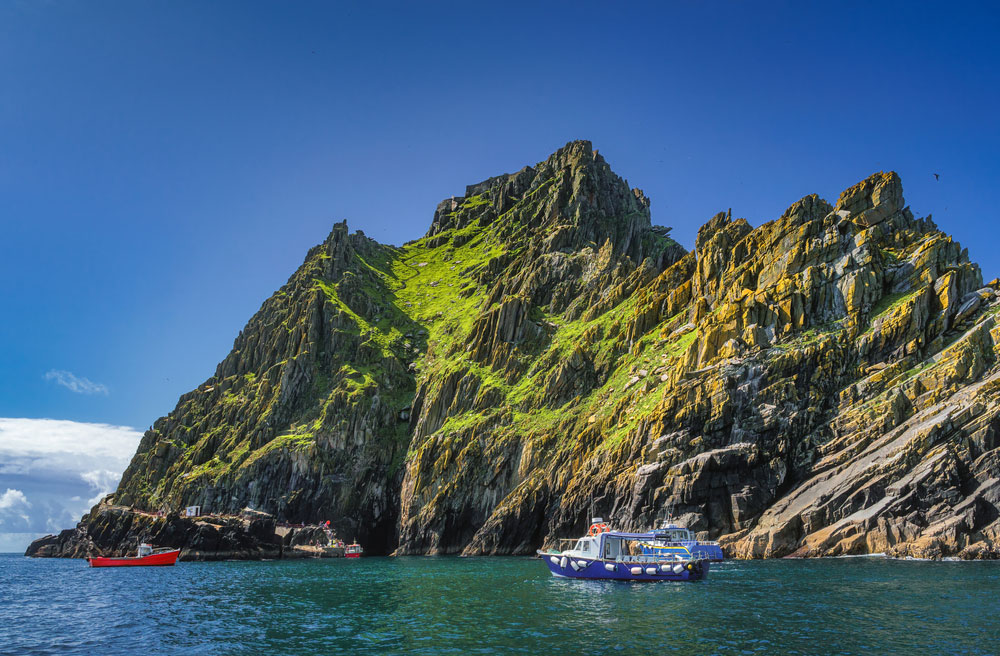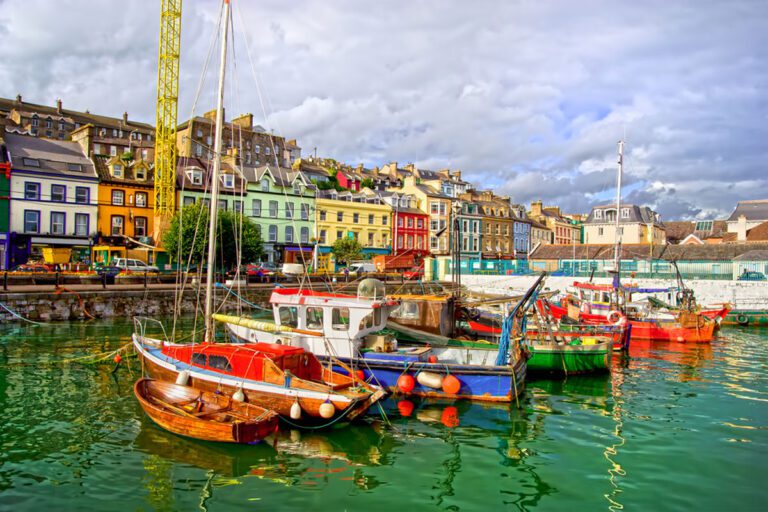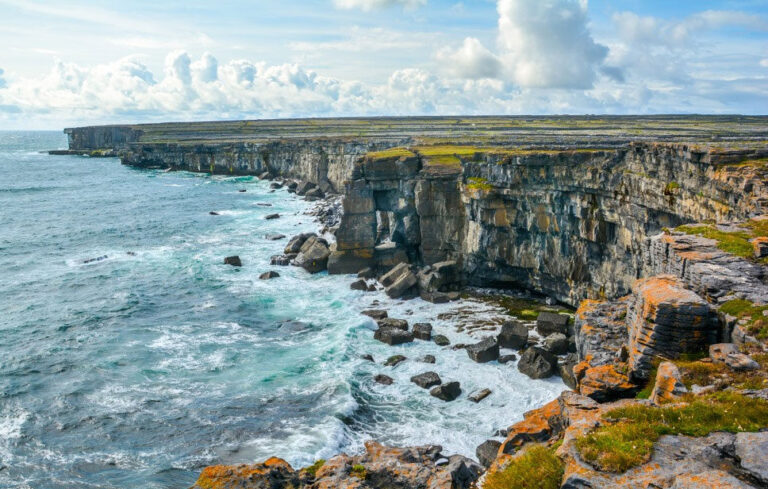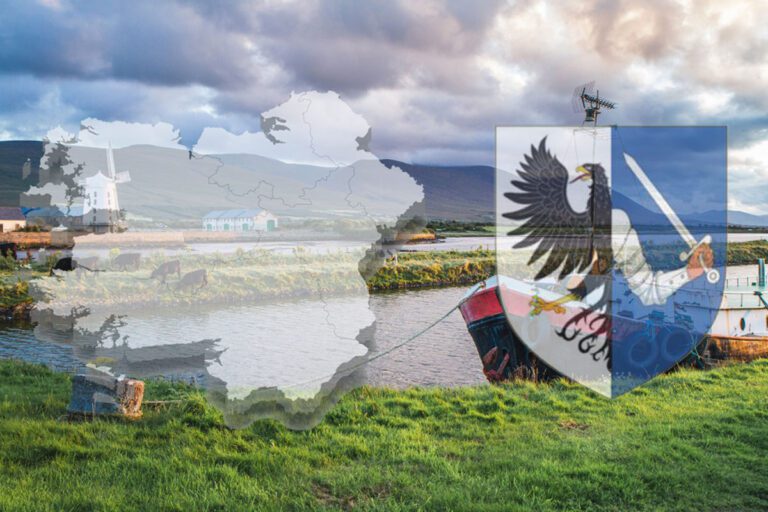A Journey to the Remote Skellig Islands
The Skellig Islands are a location of enchantment and mystery off Ireland’s rocky Atlantic coast. These lonely isles, like ancient sentinels rising from the depths of the sea, have long caught the minds of travelers seeking a taste of Ireland’s raw beauty. As we embark on this incredible journey, the whispers of history and the allure of nature lead us to a world that time seemed to have forgotten.
The voyage begins at the gorgeous village of Portmagee, where we board a boat to sail the glistening seas of the Atlantic. The panorama changes with each stroke of the oars, presenting the stunning magnificence of the Skellig Islands on the horizon. The islands appear as guardians of an old realm, shrouded in a mysterious aura that draws us in.
Navigating the unpredictable seas, we approach the larger of the two islands, Skellig Michael, a UNESCO World Heritage Site and the epitome of solitude and sanctuary. Its steep cliffs and rocky outcrops exude an aura of isolation, where the harmony between man and nature thrives. Once inhabited by monks seeking spiritual solitude in the 6th century, the island’s history is etched in the weathered stones of its monastic ruins.
We feel as if we’ve stepped back in time as we step ashore. The ruins of beehive houses and an antique chapel appear to speak of the devout monks who once found refuge and tranquillity in these rough landscapes. The Skelligs are a tribute to the human spirit’s resilience, ensconced in nature’s embrace and undisturbed by the contemporary world.
But the Skellig Islands’ fascination goes far beyond their historical significance. The rocky cliffs and turquoise waters support a complex ecology of animals, including puffins, gannets, and seals. The screams of seagulls fill the air as we travel the meandering roads, creating a symphony of nature’s melody.
Wildlife Sanctuary: A Symphony of Nature’s Wonders
The Skellig Islands awaken to a symphony of nature’s delights as the sun rises above them. The islands provide a shelter for a vast diversity of species that call these rough settings home. We become witnesses to a stunning tapestry of life as we journey deeper into this untamed domain, where the dance of seabirds, the joyful antics of seals, and the rhythmic lapping of the waves make a perfect symphony.
The Skelligs are well-known for being a seabird breeding place, with puffins taking center stage in this avian extravaganza. With their bright beaks and hilarious waddling, these distinctive birds find refuge in the rocky cliffs and burrows they call home. Their calls fill the air from the moment we set foot on Skellig Michael, rebounding across the ancient stone structures and cliffs, producing a lively symphony that is music to our ears.
We come upon another beloved resident, the gannet, as we glide effortlessly across the beautiful waters around the islands. With their dazzling white plumage and acute eyes, these beautiful birds plunge from vast heights to catch fish in their powerful beaks. Observing their command of the sea reminds us of the delicate balance that preserves this fragile environment, in which every organism plays an important part.
We see seals lazing in the sun among the craggy rocks, their sleek bodies fitting in with the surrounding scenery. They examine our presence with a keen eye, reminding us that we are only visitors in their domain. The playful antics and beautiful grace of the seals inspire amazement and a deep awareness for the interdependence of all living species.
As the day progresses, the Skelligs reveal more of their secrets. The undersea world is equally as bright and enthralling as the one above it. We see beautiful sea life beneath the waves, from vibrant anemones to curious fish dashing through the kelp forests. The marine life on these distant islands has remained unspoiled, a testament to their preservation.
We are reminded of the delicate balance of life and the significance of maintaining these rare ecosystems as we take in the grandeur of the Skellig Islands. The islands serve as a reminder of the connection of nature and humanity, urging us to be better planet stewards.
A Glimpse into the Monastic Past: Mysteries of Skellig Michael’s Legacy
A look into the island’s monastic past lies among Skellig Michael’s rough topography. We are transported back in time when we enter the hallowed grounds of this UNESCO World Heritage Site, to a period of dedicated monks seeking spiritual isolation in the midst of nature’s beauty.
The monastery hamlet, perched dangerously on the cliffs, is a tribute to the dedication and resilience of individuals who formerly called this lonely isle home. The beehive homes, built from stone without the use of mortar, induce awe for the modest yet inventive craftsmanship of these medieval hermits. These circular buildings, which resembled beehives, served as both refuge from the elements and places of reflection and prayer.
Among the monastic ruins, an enigmatic stone structure known as the “Stairs of the Sea” captures our attention. Carved into the cliffs, this impressive stairway of ancient steps leads to the upper reaches of the island, connecting the lower and upper monastic complexes. We can only imagine the spiritual journey these steps symbolized for the monks, ascending towards the heavens as they sought divine enlightenment amidst the vast expanse of the sea.
We are impressed by the loneliness and isolation that formerly surrounded the monks as we visit the monastery. The isolation of Skellig Michael was intended, allowing these devoted souls to find comfort and devotion away from the distractions of the world. Their style of life was an ode to simplicity and dedication, as they lived in tune with nature and their spiritual beliefs.
However, the Skelligs’ impact stretches beyond their monastery history. Many seamen and visitors have passed through the islands over the years, with stories of sailors seeking shelter and pilgrims seeking spiritual communion. The worn rocks and ancient ruins have endless stories to tell, their mysteries reverberating down the years.
The Skellig Islands have recently caught the imaginations of people from all over the world, attracting both filmmakers and daydreamers. The iconic Star Wars sequences were recorded here, among these magical vistas, a tribute to the ethereal attraction of this intriguing environment.
Yet, amidst the allure of fame and the footprints of history, the Skelligs remain a sanctuary for nature and a testament to the enduring spirit of humanity. The delicate balance between the past and the present, the natural and the mystical, is what continues to captivate all who venture to these remote isles.
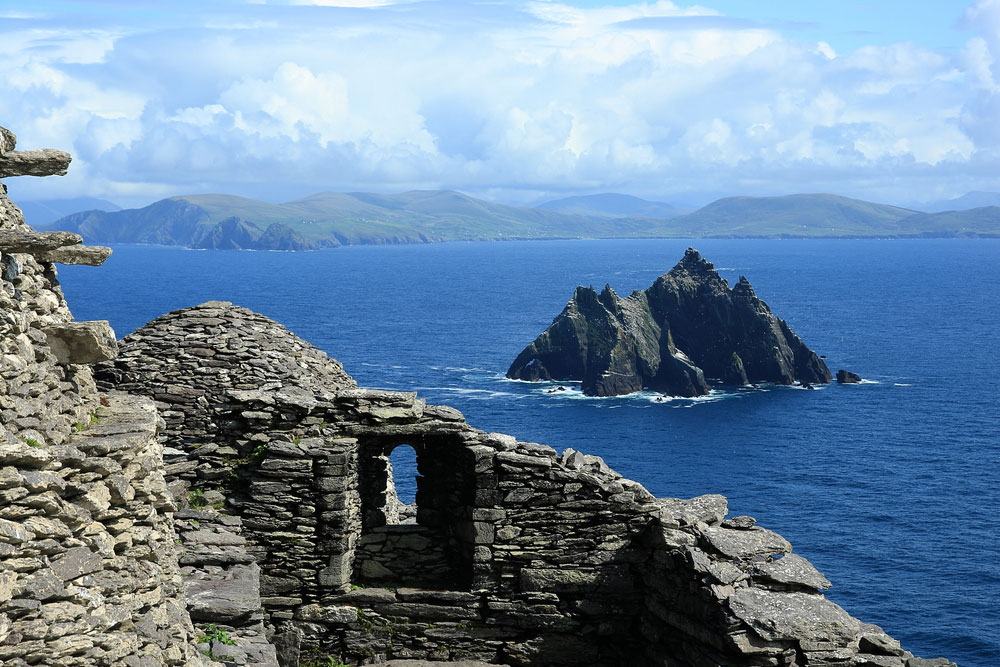
Botanical Treasures: The Flora of Skellig Islands
We find a hidden world of plant marvels that decorate these ancient coasts as we meander across the rocky landscape of the Skellig Islands. The robust vegetation, which is resistant to the Atlantic winds, lends a sense of wonder and splendor to the already compelling landscape. From rare orchids to brilliant wildflowers, each plant tells a story of adaptation and survival in the midst of these distant isles’ harsh beauty.
The Arctic-Alpine Navelwort (Omphalodes littoralis) is one of Skellig Michael’s most famous and beloved residents. This exquisite blue wildflower, found only in a few chosen areas along the Irish coast, seeks refuge on the island’s rocky cliffs. Its existence is a reminder of the diversified ecosystem’s various microclimates, where life clings to every crevice of the rock.
Among the lush greens, we come across the bright yellow blooms of the Kidney Vetch (Anthyllis vulneraria), a plant that plays an important function in the ecology. Its nectar-rich blossoms attract a wide range of pollinators, including butterflies and bees, making it an important contributor to the island’s biodiversity.
We discover the lovely Pyramidal Orchid (Anacamptis pyramidalis) embellishing the landscape with its delicate pink spikes as we explore the secret nooks and crannies. These endangered orchids have found shelter on the island, where they thrive in the absence of invasive species and human interference.
The enticing aroma of Wild Thyme (Thymus serpyllum) fills the air as we continue our botanical research. With its little purple blossoms, this aromatic plant carpets the ground, bringing both beauty and flavor to the landscape. Herbalists have traditionally valued its leaves for their medicinal and culinary benefits.
Among the rocks and stones, we come across the Sea Campion (Silene uniflora), a plant that has evolved to flourish in tough coastal conditions. Its beautiful white blossoms, which like fragile pearls, appear to glow against the dark rocks, serving as a sign of nature’s artistry.
As we immerse ourselves in the botanical wonders of the Skelligs, we are reminded of the delicate balance that sustains this rugged ecosystem. These plants, carefully adapting to the winds and weather, symbolize the tenacity of life and the intricate interplay between flora and fauna.
We find a shelter for nature’s treasures in this distant part of Ireland, unspoiled by the hands of modernization. The Skellig Islands’ flora serves as a reminder of the importance of protecting these delicate ecosystems, where every living being contributes to the beautiful tapestry of life.
The Enduring Magic: A Wonder-Filled Legacy
The beauty of this lonely and mythical region lingers in our hearts as our voyage on the Skellig Islands comes to an end. The enduring appeal of these ancient isles leaves an indelible impact on all who have had the luxury of setting foot on their shores. With their rich history, numerous wildlife, and floral wonders, the Skelligs have left a legacy of wonder that transcends time.
Skellig Michael’s intriguing monastic heritage is a monument to the resilience and devotion of individuals who sought shelter amidst these harsh environments. The old stone structures, aged by centuries, remind us of the human spirit’s everlasting force and the timeless desire for spiritual enlightenment.
As we explored the abundant wildlife that thrives amidst the cliffs and waves, we witnessed a harmonious symphony of nature’s wonders. The seabirds soaring in the skies, the seals basking on rocky outcrops, and the vibrant marine life beneath the waves form an intricate dance that celebrates the interconnectedness of all living beings.
The plant marvels that adorn the Skellig Islands lend another degree of enchantment to this already spectacular scenery. From rare wildflowers to aromatic herbs, the Skelligs flora has adapted to the roughest of conditions, demonstrating nature’s persistence and beauty.
The Skelligs’ most enduring magic, though, is their power to touch the human soul. The sense of amazement and wonder that rushes over us as we explore these remote coastlines invites us to halt, contemplate, and appreciate the natural world’s treasures.
The Skellig Islands, with their ancient mysteries and pristine beauty, serve as a reminder of the difficult balance between human presence and environmental preservation. It’s a place where the past and the present collide, where history echoes in the breezes and where every rock and blade of grass has a story to tell.
As we wave farewell to this secluded sanctuary, we take echoes of its enduring magic with us. The Skelligs become a part of us, woven into the tapestry of our own stories and treasured in our memories.
So the adventure to the Skellig Islands comes to an end, but the legacy of wonder continues. These mysterious islands, where history and nature collide, leave us feeling tremendous gratitude for the natural beauties that bless our globe.
May the Skelligs continue to inspire future generations, asking them to enjoy the wild’s enchantment and beauty. Let us celebrate and safeguard these remarkable regions, leaving a legacy of wonder for everyone who seek solace, adventure, and enchantment among our planet’s harsh terrain.
Here are some more famous tourist attractions in County Kerry:
- Ring of Kerry: A scenic driving route that takes you through picturesque landscapes, charming villages, and breathtaking coastal views.
- Killarney National Park: One of Ireland’s most renowned national parks, offering pristine lakes, ancient woodlands, and the famous Torc Waterfall.
- Dingle Peninsula: Known for its rugged cliffs, sandy beaches, and Gaelic heritage, the Dingle Peninsula is a must-visit destination for its scenic beauty.
- Gap of Dunloe: A narrow mountain pass surrounded by towering peaks, offering spectacular views and hiking opportunities.
- Ross Castle: A historic castle located on the shores of Lough Leane near Killarney, providing insights into Ireland’s medieval past.
- Muckross House and Gardens: A beautiful Victorian mansion with stunning gardens set within Killarney National Park.
- Slea Head Drive: A scenic coastal route on the Dingle Peninsula, offering breathtaking views of the Atlantic Ocean and ancient archaeological sites.
- Inch Beach: A long sandy beach perfect for surfing, walking, or simply enjoying the stunning Atlantic views.
- Kerry Cliffs: Majestic cliffs offering panoramic views of the Skellig Islands and the Atlantic Ocean.
- Gallarus Oratory: An ancient stone church dating back to the 6th century, one of the best-preserved early Christian sites in Ireland.
- Carrantuohill: Ireland’s highest peak and a popular destination for hikers and mountaineers.
- Ballybunion Beach: A beautiful Blue Flag beach renowned for its golden sands and excellent surfing conditions.
- Valentia Island: An island with a fascinating history, featuring the Valentia Island Tetrapod Trackway and stunning coastal scenery.
- Blasket Islands: A group of islands off the Dingle Peninsula, famous for their literary and cultural heritage.
Recommended Reading:
Helpful Resources:

